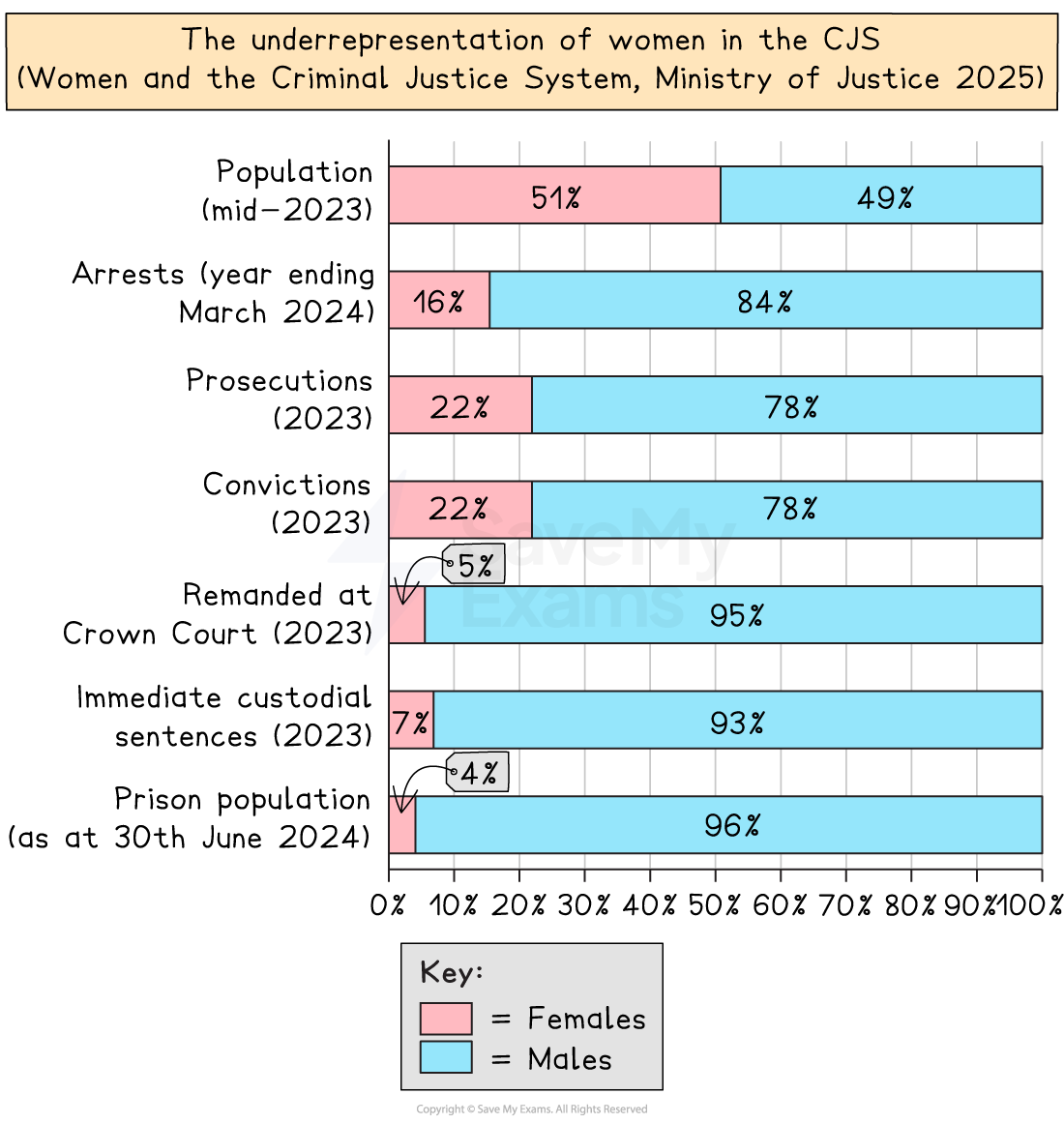Gender & Criminal Behaviour (AQA A Level Sociology): Revision Note
Exam code: 7192
Statistics on gender & crime
The overall pattern is that official statistics consistently show women commit less crime than men
Key facts (Ministry of Justice, 2025)
Prison population:
As of June 2024, only 4% of prisoners were female — a figure that has stayed stable for the last five years
First-time offenders:
In 2023, 27% of female offenders were first-time offenders compared to 21% of males
Arrests:
In 2023/24, females accounted for 16% of arrests, while males made up 84%
Indictable offences:
Only 14% of female offenders were sentenced for indictable offences in 2023, compared with 26% of male offenders
Custodial sentences:
The average prison sentence for women in 2023 was 12.2 months, compared with 21.8 months for men
Convicted offenders:
About 4 in 5 convicted offenders in England & Wales were male.
Types of crime
Female offending patterns:
Women are more likely to be convicted of property offences (e.g., theft, criminal damage, arson)
Theft accounted for a slightly larger share of female arrests (15%) than male arrests (14%)
Male offending patterns:
Men dominate in violent crimes, such as homicide and sexual offences
In 2022/23, 7% of males and 1% of females committed a sexual offence

Debates about female criminality
These statistics can be interpreted in two contrasting ways:
Official statistics underestimate female offending
Some sociologists and criminologists argue that women commit more crimes than official figures suggest, but their offending is hidden by the system
Women may be treated more leniently by police and courts, and their crimes are often less likely to be reported or recorded
E.g., shoplifting is less visible and less likely to be prosecuted compared to violent offences
The statistics are largely accurate
Many feminist sociologists argue that women genuinely commit fewer crimes than men
They suggest this is because women are often more controlled in society and have fewer opportunities to commit crime, particularly serious or violent offences
The chivalry thesis
Suggests that the criminal justice system (CJS) is more lenient towards women, treating them with chivalry and paternalism
Otto Pollak (1950) argued that men (police, judges) are protective of women, so female crime is underreported and underpunished
Females do not fit police stereotypes about suspicious or criminal behaviour and so are less likely to be stopped, arrested or charged
If women are caught committing an offence, Pollak argues, they are subjected to 'softer' treatment than men and are often released with a warning
This lenient treatment of women by male police officers is known as the chivalry thesis
Evaluation of the chivalry thesis
Strengths
Self-report studies
Some self-report studies suggest women commit more crimes than OCS indicates
Graham & Bowling (1995) and Flood-Page et al. (2000) found that women admit to more crime than official statistics record
Flood-Page et al. also found that women were more likely than men to be cautioned rather than prosecuted — only 1 in 11 female self-reported offenders had been cautioned or prosecuted, compared to 1 in 7 males.
Further research support
Steffensmeiser & Allan (1996) argued that judges may treat women more leniently, often citing reluctance to separate mothers from children or a belief that women are less dangerous
Hood (1992) found in a study of 3,000 cases that women were one-third less likely to be sent to prison than men for similar offences
Criticisms
Self-report studies
Other self-reports show that men admit to more offending
Young men are more likely than young women to report binge drinking, drug use, and disorderly behaviour
Hales et al. (2009) found that men were significantly more likely to have offended in all major categories
Research evidence critique
Some studies find little or no difference in sentencing
Farrington & Morris (1983) found that men and women often received similar punishments for comparable offences
Bias exists, but not always leniency
Women can face harsher treatment if they break gender norms
Heidensohn (1985) argued that courts punish women more severely for behaviours such as promiscuity or neglect of children
Carlen (1997) claimed women who fail to conform to the ideal of a 'good mother' may face harsher sentencing
Intersectionality
Gender does not operate alone — ethnicity, class, and age also shape outcomes
The chivalry thesis ignores that black and working-class women may face harsher treatment due to police stereotyping and racial profiling
Victimisation patterns
Women are more likely to be victims than offenders
In 2022/23, females were the victims in 59% of homicides where the suspect was known to them, compared to 41% for male victims (MoJ, 2025)
A patriarchal criminal justice system
Feminists argue that the CJS is patriarchal and often blame women
There are examples of judges making sexist, victim-blaming remarks
Walklate (1998) argues that in rape trials, women often have to prove their respectability to be believed, making it feel like the victim is on trial
Examiner Tips and Tricks
To secure top AO2 marks, apply the chivalry thesis to contemporary news. This shows you can link theory to real criminal justice dynamics, not just memorise studies and their findings.
The Independent (2023) (opens in a new tab) coverage of Prison Reform Trust data reports that over half of women’s prison sentences in 2022 were under six months, with shop theft a key driver.
Link to the chivalry thesis: This reflects paternalism/chivalry in sentencing (shorter terms; 'less dangerous'/caregiver assumptions)
The Independent (2024) (opens in a new tab) report finds that sexual violence survivors face rape-myth questioning and misogyny during cross-examination
Link to the chivalry thesis critique: evidence of victim-blaming and patriarchal courtroom culture rather than blanket chivalry towards women in the CJS
Use examples like these in essays to show you can apply the chivalry thesis to real contexts — e.g., cautioning vs prosecution, bail and sentencing decisions for women, and courtroom treatment of women as victims — demonstrating both evidence for and against leniency.

Unlock more, it's free!
Did this page help you?